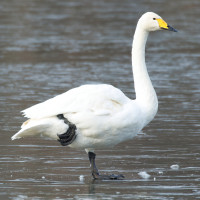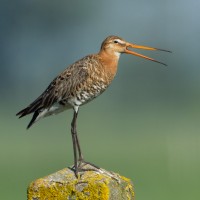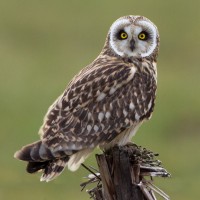Description
A popular birding site in north west Cheshire, that is close to Liverpool, Chester and Manchester and served by good motorway and road/rail/bus networks. Ideal for water birds, waders/shorebirds, wildfowl, passerines and raptors.
Ideal in all seasons with wintering Common Sandpiper and Common Chiffchaff. Huge numbers of wintering Eurasian Teal & Wigeon, bountiful numbers of passage/summering Black-tailed Godwits, scarse and rare birds occur frequently A recent roost (winter 2020-2021) of 13, 450 Pink-footed Goose on the south Mersey salt marshes. Occasional oddities like Todd's Canada, Russian White-fronted, Brent, Barnacle Geese and possible Green-winged Teal.
Spring can produce passage Green & Wood Sandpiper with Ruff in fine breeding plumage. Also big numbers of Northern Wheatear, Western Yellow Wagtail and Whinchat on passage.
Summer for returning shorebirds and the possibility of finding a rare N. American or Eurasian wader. Osprey, Hobby and European warblers both breeding and passage species.
Autumn can bring up a few surprises and has had numerous N. American shorebirds. Good for passage migration. Shorebirds are moving through in ernest with possible passage of Curlew Sandpiper, Little Stint, Whimbrel and Bar-tailed Godwit.
Winter is ideal for wintering duck with regular Greater Scaup, Long-tailed Duck, Common Goldeneye, Tufted Duck, Common Shelduck and Common Pochard. European Stonechat winter in good numbers and European Golden Plover and Northern Lapwing are common. Short-eared Owl can be found hunting the rough grassy fields with occasional Barn Owl and Hen Harrier.
Details
Access
Access is from Main Street in the village/town of Frodsham. Take the right-hand turn at the south end of Main Street onto Marsh Lane. Park on the bridge that crosses the M56 motorway and bird watch on foot.
If you do decide to drive your car onto the site be mindful of the many concealed (if wet) pot holes.
Wlking from the bridge over the motorway and to access the River Weaver walk ahead onto Brook Furlong Lane. At the ramp track follow the track until you come to the first cattle gride on the road. At this point look across the pipes on your right hand-side where is an area which is good for Northern Wheatear and Ring Ouzel in the Spring and Autumn/Fall and Short-eared Owl frequent the area in late Winter/early Spring. Walking further along the track until you reach the farm buildings and stop at the second cattle grid. From here is a spot to view the Mersey Estuary and its shorebirds and great views of the Liverpool Skyline to the west. Below the farm is the Manchester Ship Canal and always worth checking out.
An alternative to this walk is to retrace your steps and where the ramps track decends take the muddy track to your left. Follow this until you reach the River Weaver. A raised bank skirts the course of the water to the east and west. Taking the right-hand side path follow to the Weaver Bend, a good area for winter ducks and swans. To your right is the Weaver Estuary, but is within an area owned by the Manchester Ship Canal Company and thus is private. It is possible with a telescope to view ducks wintering in the area, and potential Spring/Summer Garganey.
Walking back to the motorway bridge take the right-hand tarmac track (Moorditch Lane) and follow it until you reach a short ramp track on your right. This track takes you between a raised field/wind turbines and an active sludge deposit tank. It is poosible to circumnavigate the sludge tank (No.6 tank) keeping the raised bank to your left throughout your walk. A good selection of species are to be encourtered en route. The water on the sludge tank is ideal for ducks at all seasons and Autumn/Winter are particularly best for Tufted Duck, Northern Pintail, Northern Shoveler and Eurasian Teal. There is a very good chance of finding a rare bird here. Western Marsh Harrier, Common Buzzard, Common Kestrel, Merlin, Hen Harrier and Short-eared Owl are frequently seen.
The whole area is worthy of exploration and gives a real chance of seeing big numbers of birds and a decent chance of finding something special.
Terrain and Habitat
Scattered trees and bushes , Grassland , Wetland , River , Lake , Mud flats , Reedbeds , City/village , AgricultureConditions
Flat , Open landscape , Dusty , Slippery , No shadow , High water possibleCircular trail
YesIs a telescope useful?
Can be usefulGood birding season
All year round , Spring , Autumn , Winter , SummerBest time to visit
Winter , Summer , Spring migration , Spring , Autumn , Autumn migrationRoute
Paved road , Wide path , Unpaved road , Narrow trailDifficulty walking trail
Average walkAccessible by
Foot , Bicycle , CarBirdwatching hide / platform
NoExtra info
Please follow the country code and keep gateways clear of parked vehicles. Can be exposed in strong winds, so suitable clothing is required for the season.
Links
- Frodsham Marsh Bird Blog
- FrodshamBirder
- Facebook: The Birds of Frodsham Marsh
- https://twitter.comFrodsham Marsh Birders Map: /FrodshamRoots/status/1345740954234466308/photo/1
.jpg)


